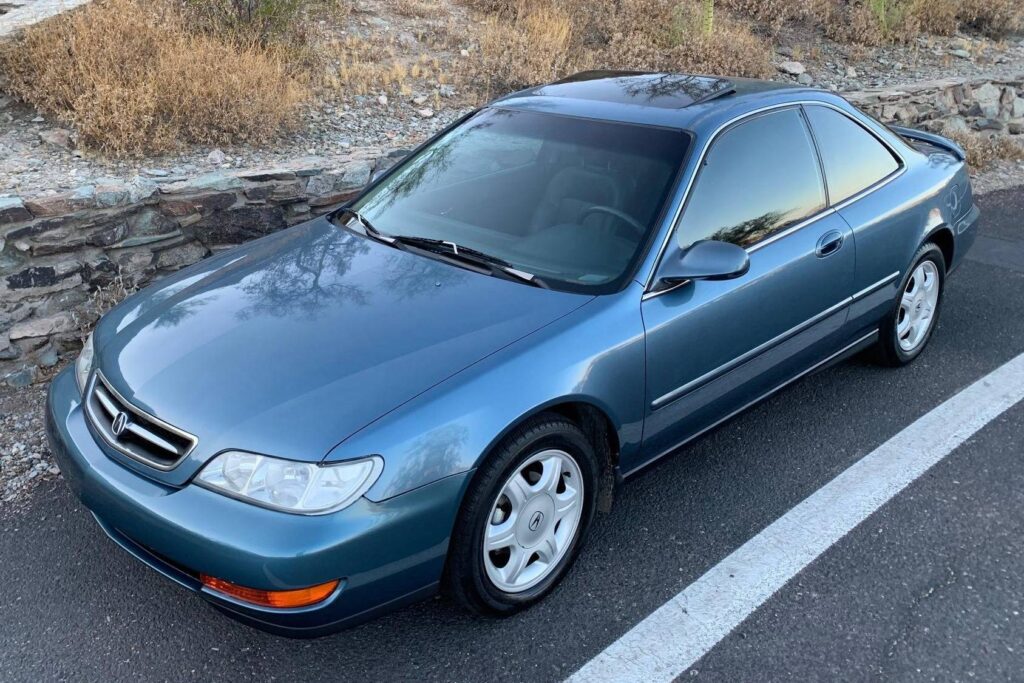The Acura TL, since its inception, has been a symbol of luxury and performance in the sedan segment. As a flagship model under the Acura brand, the TL seamlessly blends the comfort and elegance expected of a luxury vehicle with the dynamic performance and reliability that Honda, its parent company, is renowned for.
Over the years, the Acura TL has carved out a niche for itself, competing with stalwarts in the luxury sedan category and often emerging as a preferred choice for those seeking a blend of style, luxury, and performance.
Key Takeaways:
- Significance of the Acura TL: The Acura TL stands as a notable model in the luxury sedan segment, offering a blend of performance, comfort, and reliability.
- Transmission System Evolution: Over the years, the Acura TL has seen advancements in its transmission system, adapting to technological innovations and enhancing the driving experience.
- Fluid Capacity and Type: Each generation of the Acura TL has specific transmission fluid types and capacities. Using the correct fluid is crucial for the transmission’s optimal functioning.
- Maintenance is Key: Regularly changing the transmission fluid, as per manufacturer recommendations, can significantly extend the lifespan of the transmission and improve vehicle performance.
- Recognizing the Signs: Being aware of the indicators that suggest a need for a transmission fluid change or flush can prevent potential damage and costly repairs.

However, like any high-performance machine, the Acura TL demands meticulous care and maintenance to deliver its best. One of the most critical aspects of this care regimen is the maintenance of its transmission fluid. The transmission system is the heart of the car’s drive mechanism, and the fluid is its lifeblood.
Ensuring the right quality and quantity of transmission fluid is not just about keeping the car running; it’s about preserving the smoothness of the drive, the responsiveness of the gear shifts, and the overall longevity of the transmission system.
Regular checks and timely changes of the transmission fluid can mean the difference between a car that serves reliably for years and one that faces frequent mechanical issues.
Acura TL Transmission Fluid Capacity And Type
Note: The information provided is for general informational purposes only. It’s always best to consult the vehicle’s manual or a professional mechanic for specific details related to your vehicle’s transmission fluid.
1996 – 1998 Acura TL

| Transmission | Fluid capacity | Fluid type |
|---|---|---|
| 4-speed M1WA automatic | Total fill: 7.2 liters (7.6 quarts) | Honda ATF-Z1 or Dexron III |
| 4-speed M5HA automatic | Total fill: 7.2 liters (7.6 quarts) | Honda ATF-Z1 or Dexron III |
1999 – 2003 Acura TL

| Transmission | Fluid capacity | Fluid type |
|---|---|---|
| 5-speed M7WA automatic | Total fill: 7.2 liters (7.6 quarts) | Honda ATF-Z1 |
2004 – 2008 Acura TL

| Transmission | Fluid capacity | Fluid type |
|---|---|---|
| 6-speed manual | 2.2 liters (2.4 quarts) | Acura MTF |
| 5-speed BDGA automatic | Total fill: 7 liters (7.4 quarts) | Honda ATF-Z1 |
- Fits various makes and models
- Carefully check vehicle fitment before purchase
- Designed to meet or exceed original part specifications
- MANUAL TRANS FL
2009 – 2014 Acura TL

| Transmission | Fluid capacity | Fluid type |
|---|---|---|
| 5-speed BK3A automatic | Total Fill 7.5 liters (7.9 quarts) | ATF DW-1 |
| 5-speed BK4A automatic | Total Fill 7.7 liters (8.1 quarts) | ATF DW-1 |
| 6-speed MMGA automatic | Total Fill 7.1 liters (7.5 quarts) | ATF DW-1 |
| 6-speed MMHA automatic | Total Fill 8 liters (8.5 quarts) | ATF DW-1 |
| K6M8 6-speed manual | 2.1 liters (2.3 quarts) | Acura MTF |
- Fits various makes and models
- Carefully check vehicle fitment before purchase
- Designed to meet or exceed original part specifications
- MANUAL TRANS FL
Acura TL Transmission Overview: A Journey of Evolution and Excellence
The Acura TL’s transmission system is a marvel of engineering, designed to deliver power from the engine to the wheels in the most efficient and smooth manner. Over the years, the TL has been equipped with both automatic and manual transmission systems, each fine-tuned to provide optimal performance, fuel efficiency, and driving pleasure.
The automatic transmissions, in particular, have been lauded for their seamless gear shifts, responsiveness, and adaptability to different driving conditions. They come equipped with multiple gears, allowing the vehicle to operate at the best possible efficiency, whether you’re cruising on the highway or navigating city traffic.
The manual transmissions, on the other hand, have been a favorite among driving enthusiasts, offering a level of control and engagement that’s hard to match.
Evolution of the Transmission System Across Different Generations of Acura TL
- 1st Gen (1996 – 1998, UA1-UA3): The first generation of the Acura TL came with a 4-speed automatic. These early models set the foundation for the TL’s reputation for smooth gear shifts and reliable performance.
- 2nd Gen (1999 – 2003, UA4-UA5): This generation saw the introduction of a more refined 5-speed automatic transmission with Sequential SportShift, allowing for manual gear selection. The manual transmission also evolved to a more robust 6-speed system in certain models.
- 3rd Gen (2004 – 2008, UA6-UA7): The third generation continued with the 5-speed automatic transmission but introduced advanced features like Grade Logic Control, which adjusted gear shifts based on the vehicle’s incline. The 6-speed manual transmission was also further refined for better performance.
- 4th Gen (2009 – 2014, UA8-UA9): The fourth generation of the Acura TL saw the introduction of a 6-speed automatic transmission, offering even smoother shifts and better fuel efficiency. The manual transmission remained a 6-speed system but was fine-tuned for even better responsiveness.
Throughout its journey, the Acura TL’s transmission system has seen continuous improvements, with each generation building on the successes of the previous one. The focus has always been on delivering a driving experience that’s both exhilarating and comfortable.
Whether you’re a fan of the manual transmission’s direct control or the ease and sophistication of the automatic system, the Acura TL has consistently delivered a transmission system that stands out in the luxury sedan segment.
Signs You Need a Transmission Fluid Change or Flush
The transmission is a crucial component of your vehicle, ensuring that power is effectively transferred from the engine to the wheels. Proper maintenance, including regular transmission fluid changes, is essential for its optimal functioning.
Here are some indicators that suggest your Acura TL might need a transmission fluid change or a complete flush:
- Dark or Burnt Fluid Color: Fresh transmission fluid is typically a bright red color. Over time, as it collects contaminants and breaks down, it can turn darker, eventually becoming brown or even black. If the fluid has a burnt smell, it’s a clear sign that it needs to be changed.
- Slipping Gears: If your vehicle unexpectedly changes gears or has difficulty staying in gear, it could be due to old or low transmission fluid affecting the hydraulic power needed for smooth gear shifts.
- Delayed or Rough Shifting: If there’s a noticeable delay when shifting from park to drive or if shifts between gears feel rougher than usual, it might be time to check your transmission fluid.
- Unusual Noises: If you hear grinding or whining noises when the vehicle is in gear, it could be a sign of low or contaminated transmission fluid.
- Transmission Overheating: Overheated transmission fluid can cause significant damage to your transmission. If your transmission temperature warning light comes on or if you notice a burning smell, it’s essential to check the fluid and the transmission immediately.
- Surging or Stalling: Old or dirty transmission fluid can cause your vehicle to surge forward or stall for a moment, as it can’t ensure the smooth flow needed for optimal transmission operation.
- Fluid Leaks: If you notice red or brown puddles or spots under your vehicle, it could be a sign of a transmission fluid leak, which can lead to low fluid levels.
- Check Engine Light: While the check engine light can illuminate for various reasons, one potential cause could be issues with the transmission or the transmission fluid.
- Clutch Problems (for manual transmissions): If the clutch stays engaged and causes grinding when trying to shift, it could be due to contaminated fluid.
- Unresponsive Transmission: If there’s a delay in the vehicle moving after you’ve shifted from park to drive or if it doesn’t move at all, it’s a clear sign of a transmission problem, possibly related to the fluid.
To prevent expensive repairs, it’s important to quickly address any indications of transmission issues. Checking your transmission fluid regularly and making sure it’s at the correct level and condition can help prevent many of these problems. If you’re uncertain about the status of your transmission fluid, it’s advisable to consult a professional mechanic.
Acura TL Transmission Problems: Common Issues and Their Symptoms
The Acura TL, while renowned for its luxury and performance, has had its share of transmission issues over the years. Here’s a breakdown of some common transmission problems faced by Acura TL owners:
- Transmission Slipping:
- Symptoms: The car unexpectedly changes gears, doesn’t stay in gear, or there’s a delay in acceleration.
- Possible Causes: Worn-out clutches, faulty solenoids, or degraded transmission fluid.
- Rough Shifting:
- Symptoms: The car jerks or experiences hard shifts when changing gears.
- Possible Causes: Low transmission fluid, clogged fluid filter, or issues with the shift solenoids.
- Transmission Overheating:
- Symptoms: Burning smell, transmission warning light on, or the transmission fluid appears dark and burnt.
- Possible Causes: Low or old transmission fluid, towing heavy loads, or driving in stop-and-go traffic frequently.
- Fluid Leaks:
- Symptoms: Reddish-brown puddles or spots under the car or a noticeable drop in the transmission fluid level.
- Possible Causes: Damaged seals, gaskets, or transmission lines.
- Torque Converter Issues:
- Symptoms: Shuddering, slipping, or delayed acceleration.
- Possible Causes: Damaged or worn-out torque converter components.
- Transmission Warning Light Illuminated:
- Symptoms: The transmission or check engine light comes on without any noticeable change in driving performance.
- Possible Causes: Sensor malfunctions, transmission overheating, or other internal transmission issues.
- Failed Pressure Switch:
- Symptoms: Erratic shifting patterns or the inability to shift into certain gears.
- Possible Causes: A malfunctioning pressure switch that doesn’t signal the correct gear.
- Third Gear Clutch Pack Failures (specifically in some 3rd Gen models):
- Symptoms: No third gear or slipping in third gear.
- Possible Causes: Premature wear of the third gear clutch pack.
- Failed Shift Solenoids:
- Symptoms: Erratic shifting or the inability to shift.
- Possible Causes: Electrical or mechanical failure of the shift solenoids.
- Transmission Lock-Up:
- Symptoms: The car doesn’t move despite the engine revving.
- Possible Causes: Severe internal transmission damage or a failed torque converter.
Acura TL Transmission Fluid Change Cost
Changing the transmission fluid is a vital maintenance task that ensures the longevity and efficient performance of your Acura TL’s transmission.
Here’s a breakdown of the costs and factors associated with this service:
- The Average Cost:
- The average cost for an Acura TL transmission fluid change ranges from $180 to $250. This price includes both the cost of the fluid itself and the labor to perform the service. However, prices can vary based on location, dealership vs. independent mechanic, and the specific model year of the Acura TL.
- Factors Affecting the Cost:
- Type of Fluid: Genuine Acura or Honda transmission fluid might be more expensive than generic or aftermarket brands. However, using the recommended fluid is crucial for optimal performance.
- Labor Rates: Costs can vary based on the hourly labor rate of the mechanic or dealership. Typically, dealerships might charge more than independent mechanics.
- Additional Services: Some mechanics or dealerships might recommend additional services, like a transmission flush, which can increase the overall cost.
- Geographical Location: Labor and material costs can vary based on the region or city. Urban areas with a higher cost of living might have higher service rates.
- Tips to Save on Transmission Fluid Change Costs:
- Shop Around: Get quotes from multiple service providers to find the best deal. However, ensure that the quality of service is not compromised.
- DIY: If you have the necessary skills and tools, consider changing the transmission fluid yourself. This can save on labor costs, but ensure you follow the correct procedure.
- Look for Specials: Some dealerships or auto service centers offer specials or discounts on maintenance services. Keep an eye out for these deals.
- Regular Maintenance: Regularly checking and maintaining the transmission fluid can prevent more costly repairs in the future. Addressing issues early can save money in the long run.
- Use Recommended Fluid: While it might be tempting to opt for cheaper fluids, using the manufacturer-recommended transmission fluid can prevent potential transmission issues, saving costs in the future.
Remember, while saving money is essential, ensuring that your Acura TL’s transmission is in top condition should be the priority. Regular maintenance and using quality products can lead to long-term savings by preventing major transmission problems.
Frequently Asked Questions
- What type of transmission fluid should I use for my Acura TL?
- Answer: For most Acura TL models, Honda/Acura’s genuine automatic transmission fluid (ATF) is recommended. Specifically, many models use the “ATF DW-1” or “ATF-Z1” type. However, always refer to your vehicle’s owner manual or consult with an Acura dealership to ensure you’re using the correct fluid for your specific model and year.
- How often should I change the transmission fluid in my Acura TL?
- Answer: Acura generally recommends changing the transmission fluid every 30,000 miles. However, this can vary based on driving conditions, such as frequent stop-and-go traffic or towing. It’s always best to refer to your vehicle’s owner’s manual for specific service intervals.
- Can I change the transmission fluid myself, or should I visit a mechanic?
- Answer: If you have experience with car maintenance and the necessary tools, you can change the transmission fluid yourself. However, the process can be messy and requires precision. If you’re unsure or don’t have the proper equipment, it’s recommended to visit a mechanic or an Acura dealership to ensure the job is done correctly.
- What are the signs that my transmission fluid needs changing?
- Answer: Some signs include dark or burnt fluid color, slipping gears, rough shifting, unusual noises from the transmission, transmission overheating, or the transmission warning light coming on. Regularly checking the fluid’s color and level can help you determine when it’s time for a change.
Last update on 2025-12-22 / Affiliate links / Images from Amazon Product Advertising API

















